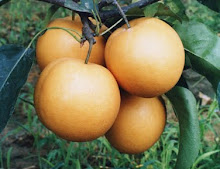But Chojiro's friend didn't give up. As if challenging Chojiro, he turned around and lent Chojiro a pair of Rogers LS3/5a speakers, which would easily fetch above US$3,000 in the second-hand market! There is no way the EMI speakers could be compared with Rogers LS3/5a - the former would be worth about US$750 in the second-hand market but Chojiro suspected anyone would be actively seeking it. Clearly these speakers belong to two different classes.
The famous LS3/5a probably needs no introduction. But for those unfamiliar with it, here is an article reproduced from the UK's Hi-Fi World audio magazine (http://www.hi-fiworld.co.uk/hfw/oldeworldehtml/rogersls35a.html) which said it all:
"Back in the early Seventies, the BBC needed a monitor 'speaker compact enough to fit into their outside broadcast vans. After extensive development work from the Beeb's Research Department what transpired was arguably the most diminutive serious hi-fi loudspeaker the world had yet seen, the LS3/5a.
A two-way infinite-baffle design squeezing a KEF B110 Bextrene mid/bass driver and 19mm mylar-dome tweeter into a cabinet just 304mm by 190mm by 160mm, it was remarkably compact. Frequency response was quoted as 70Hz-20kHz (+/-3dB), but the complex 26-element crossover and 83dB sensitivity meant the LS3/5a wasn't ideal for low-power amplifiers. And with a power handling of 25 watts 'speech and music' and a maximum SPL of 95dB, nor was it ideal for muscle amps ? it was a specialist design in the strictest sense.
As the Beeb didn't actually manufacture 'speakers itself, the LS3/5a was licensed to Rogers, Chartwell, Audiomaster, Spendor and Harbeth to produce. At first the response was mixed. People were used to far larger designs and just couldn't believe full-range 'high-fidelity' was available from such tiny boxes. And the sound was rather a shock after the big, wobbly plumminess of many larger speakers. The LS3/5as had small, rigid, well-damped cabinets with little sonic footprint, and sometimes the truth was hard to listen to!
Best characterised as clear, clean and uncoloured, particularly in the midband, LS3/5a's sound amazingly balanced even today. Another forte is imaging - with a wide, deep and consistent sound stage they're excellent on Classical and choral music, where voices and individual instrument groups in the orchestra are faithfully rendered.
As the saying goes, the LS3/5as are like much bigger loudspeakers minus the low bass. And that's the problem - they just can't shift air like boxes with big cones and really go to pieces if asked to. Another failing is the treble, which is pleasantly sweet but not the most transparent in the business.
The BBC revised the crossover in 1988 and the load was no longer specified at 15 ohms. Quoted impedance became nominally 11ohms. Subsequently bi-wiring was introduced and the LS3/5a became the speaker it is today, with a power handling of 80watts. And in 1995 Rogers introduced a matching stand-type subwoofer, the £549 AB1s. With an extra B110 kicking in below 120Hz, they transformed the LS3/5a into an even more attractive prospect. Not only do they go deeper, they'll also go louder and sound a lot less constrained when asked to boogie. Although not ideal Rock transducers, the LS3/5a/AB1s make a very respectable job of it.
Throughout its long life, several variants of the LS3/5a have surfaced, most interesting of which was the JR149. Designed by Jim Rogers, one of the great and the good in the BBC's Research Department, it uses the same drivers as the LS3/5a in a cylindrical aluminium housing. Aside from looking radical, the cylindrical enclosure is more rigid and holds fewer standing waves, making for an arguably better sound.
But the most successful LS3/5a spin-off is Harbeth's HL-P3ES. Although departing from the original in many ways, they're very much the LS3/5a in a modern setting ? with a smoother, cleaner, tighter and more detailed sound.
The great thing about LS3/5a's is that they're readily available second-hand, and their owners rarely use them as party 'speakers! Go for as new a model as you can, preferably with the phase two bi-wireable crossovers.
A pair of brand new Rogers LS3/5as costs £699 (in Walnut, black Ash or Teak), so pay between £100 and £500 second-hand, depending on age and condition. As for the different brands of LS3/5a, this is a veritable snake pit of controversy, but if they didn't all sound practically the same, the Beeb would not be amused!"
The Rogers LS3/5a lent to Chojiro were the original 15-ohm version. The fact that they were no longer in production made them a "collector's item". Some die-hard enthusiasts claim that the 15-ohm version sounds much better than its 11-ohm counterpart. Of course, very subjective judgment is involved but as it stands the prices quoted for second-hand LS3/5a speakers in the Hi-Fi World article are way off the mark.Shortly after Chojiro hooked up his Leak Stereo 60 power amplifier to the Rogers LS3/5a, another friend offered a pair of Canadian made Reference 3a Dulcet speakers for trial. Chojiro gladly accepted the offer. Why not, he thought. He could always switch between these two pairs of speakers for A-B tests.
 (Pictured above: Rogers LS3/5a on speaker stands in the front)
(Pictured above: Rogers LS3/5a on speaker stands in the front)
 (Pictured above: Reference 3a Dulcet front and back views)
(Pictured above: Reference 3a Dulcet front and back views)Upon actual testing, Chojiro found the Roger LS3/5a and Reference 3a Dulcet speakers to be largely on par, with the Dulcet delivering much deeper bass and higher treble than the LS3/5a. Overall, Dulcet is the better performer; but LS3/5a has a magical touch, particularly in the mid-range, that makes you keep wanting to go back to it. No wonder the LS3/5a commands such a huge following. Chojiro is hooked on it.










